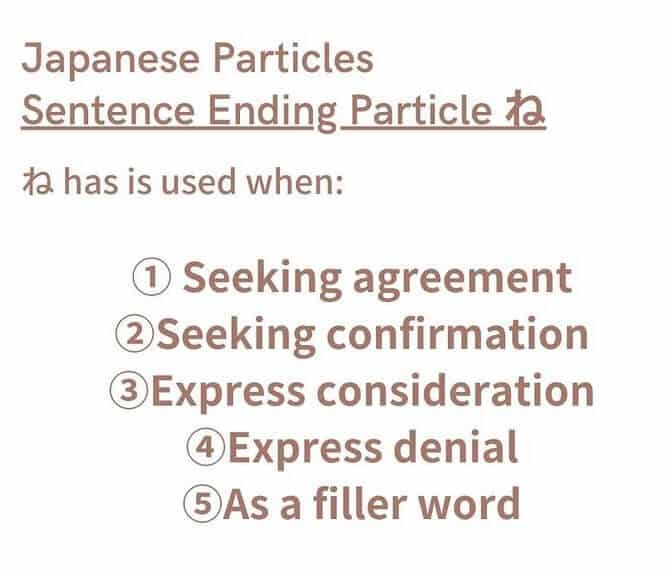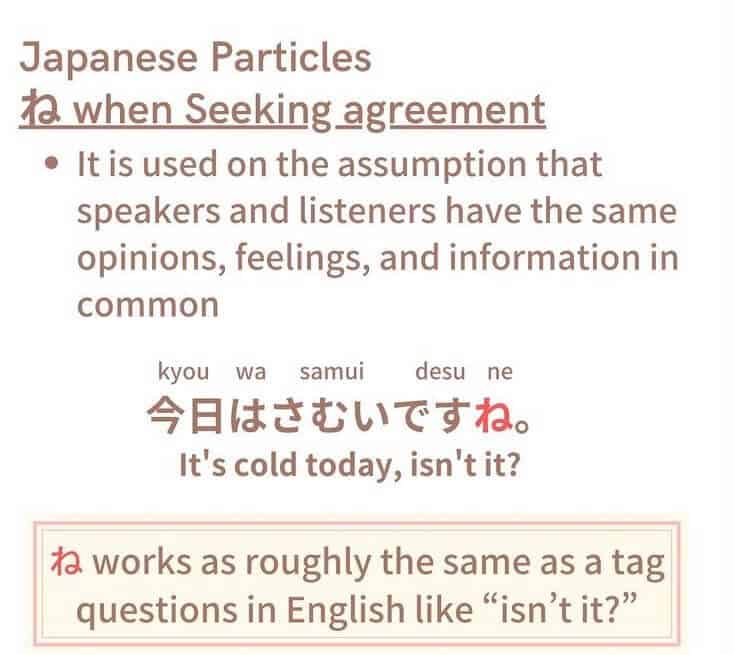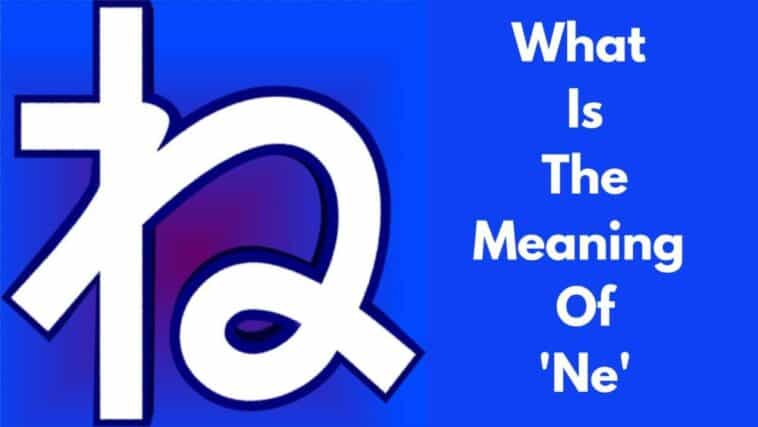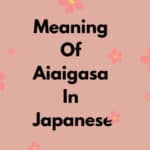Have you ever heard of the Ne (ね) in Japanese. Knowing how and when to use ‘Ne’ in Japanese is like placing a cherry on top of your Japanese learning sundae.
Just like most people, I too started picking up many Japanese phrases and pronunciations from anime shows and dramas.
So, when I started learning Japanese, I had a really hard time wrapping my mind around the particle Ne (ね).
While some other particles in Japanese have pretty definite and straightforward meanings, ね is not that as simple.

It has a number of different uses and meanings and can be used everywhere and anywhere.
- Related: Meaning of Mono and Koto in Japanese
- Related: Meaning of Ara Ara in Japanese
- Related: Meaning of Daijoubu
If you would really like to speak fluent Japanese, then it is necessary to understand the different meanings and uses of ね.
So, don’t let yourself walk into dozens of awkward scenarios, rather let us explore further the different meanings, uses and examples that will help you sound natural in Japanese.
Page Contents
Meaning Of ‘Ne’ In Japanese
The particle ne (ね) is a very common particle of speech that is used in the Japanese language.

It can be used casually or politely with a number of meanings attached to it.
The most common and basic translation is: ‘Isn’t it’ or ‘right?’ In this case it is used at the end of the sentence seeking confirmation.
Common examples are:
今日は早いですね
You’re early today, isn’t it?
今日はいい天気ですね
Today’s weather is good isn’t it?
It is a part of daily speech in Japan and not necessary that you need to answer every time someone says Ne (ね) at the end of the sentence. This is applicable in the above mentioned examples.
In both cases, the speaker is trying to ask for confirmation from the listener. Without the particle Ne (ね), it would just be a simple sentence that it the weather is good or that he/she is in fact early.
So, to reply to the second sentence, the listener can say: ‘そうですね’ that can be translated into, ‘It is, isn’t it? The listener is just politely confirming the speaker’s comment.
- Related: Meaning of Ohayou Gozaimasu
Besides the above, the particle ‘ne’ can be used in four different ways: asking for confirmation, or expressing agreement or exclamation softly and making sounds of phrases better.

I will soon explain how to use this particle, ‘ne’, in all four instances with examples.
Common examples of the particle ne (ね)
- Sō desu ne
そうですね
That’s right, isn’t it?
- Kyou wa doyoubi desu ne
今日 は 土曜日 です ね
Today is Saturday, right?
- Samui desu ne
寒いですね
It’s cold!
- Kono kaban wa takai desu ne
このかばんは高いですね
This bag is expensive, isn’t it?
- Kyou wa kimi tsuitenainee
今日は君ついてないねえ
Today is not your day - Tanoshii desu yo ne
楽しいですよね
This is fun, don’t you think? - Tsuki ga kirei desu ne
月が綺麗ですね
The moon is beautiful, isn’t it? - Related: Meaning of Konnichiwa
Origin Of The Particle Ne (ね) in Japanese:
Japan history had been influenced by Portugal, which many believe that ね was one of the many words that the Japanese learned from the English.
Many records state that the ne (ね) particle has been used since the Heian Period (794-1185) long before the English immigrated to Japan.
Some claim that this expression comes from Nai (ない) found at the end of sentences.
Before hiranga existed, the particle ね was written with the kanji (祢) which means ancestor and sanctuary.
Today, there is a much deeper meaning and the use of this word can be used to ask for confirmation,get attention, and even make a correction.
- Related: Meaning of Moe Moe Kyun
Different Meanings Of Ne (ね) With Examples
Using ‘Ne’ to express exclamation
ne – ね can be used a sentence-ending particle to express exclamation which sounds softer than asking one for confirmation.
Example:
Tsuki no hikari ga mabushii desu ne
月の光が眩しいですね (つきのひかりがまぶしいですね
The moonlight is bright!
In the above example, ‘tsuki’ means moon, ‘no’ is a case particle to join two nouns.
Hikari means light, Ga is a case particle to make the subject in a sentence, Mabushii means bright and Desu means is an auxiliary verb after a noun to make it polite.
The above example is a typical usage of the particle ‘ne.’ In the example, this is used at the end of the sentence by native Japanese speakers to express exclamation.
This is much softer compared to other particles and words used to express exclamation, so when you translate it into English, you wouldn’t necessarily need to add an exclamation mark.
It is very similar to the type of ‘ne’ asking the listener for confirmation but is more indirect and softer.
Ne’ to ask for confirmation:
ne – ね can be used a sentence-ending particle to ask for confirmation and can be used to add the meaning of ‘right’ at the end of the sentence.
Example:
Kanojo wa kinou gakkou ni ki ta ne
彼女は昨日学校に来たね (かのじょはきのうがっこうにきたね)
She came to school yesterday, right?
‘Kanojo’ means she and is a pronoun, ‘wa’ is a binding particle to make the subject in the sentence.
‘Kinou’ means yesterday and is both a noun and adverb, ‘Gakkou’ means school, ‘ni’ is a case particle to say where something goes, ‘ki’ means to come, ‘ta’ is an auxiliary verb to make past tense form.
This is another typical usage of the particle ne (ね). In the example, it is used at the end of the sentence to ask for confirmation such as ‘right?’ Japanese speakers use this with the pitch raised in the same way they ask questions.
- Related: Meaning of Ureshii and Tanoshii

It sounds softer compared to other particles like ‘ka’ which focuses on asking more questions directly.
‘Ne’ to express agreement:
ne – ね can be used a sentence-ending particle to express agreement. The role of this particle here is asking for an agreement in a softer way.
Example:
Hai, kyou wa atatakai desu ne
はい、今日は暖かいですね (はい、きょうはあたたかいですね)
Yes, it’s warm today
‘Hai’ means yes, ‘Kyou’ means today and works as a noun and adverb, ‘Itatakai’ means warm in Japanese.
This particle can be useful when we wish to intentionally leave the meaning of the phrase unclear.
In the example, ‘hai’ is an interjection which clearly makes us clearly understand the ‘ne’ used here at the end of the sentence expresses agreement.
Japanese native speakers use this particle here without the pitch raised.

Having the right interpretation of ‘ne’ can be difficult because not every sentence will start with ‘yes.’
‘Ne’ to make sounds of phrases better:
ne – ね can also be sued as an interjectory particle to make the sounds of phrases better.
Example:
Yoto de ne kare ni at ta
京都でね彼に会った (きょうとでねかれにあった)
I met him in Kyoto.
‘Kkyoto’ means Kyoto, the capital city. ‘De’ is a case particle to indicate when someone does something, ‘Kare’ means he, ‘Ni’ is a case particle which means to meet and indicates the direction of the action.
‘At’ means to meet and has been conjugated with the following word for better connection.
We can use this type of ‘ne’ after a noun, adjective, auxiliary verb, verb, or even a particle used to make the sounds of the phrases better.
When we want to have some sound between the phrases or words, or even make a pause between phrases, we can use this particle.
It can be a little challenging for Japanese learners to decide where to use this particle but with some experience you will be able to use this in real conversations.
- Related: Meaning of Maji in Japanese
Meaning of Ne: FAQs
What are the other uses of the particle ne (ね) ?
There are so many other uses of the particle both in modern and informal usages. While most people use it sparingly to avoid sounding immature or childish, some use it everywhere. Sometimes, it may not even be grammatically correct but it is used out of habit to break up parts of speech. If you roughly translate a few phrases in Japanese , ‘ne’ can be used to get someone’s attention like excuse me or pardon me or um. As slang, it can be used to say ‘Oh really?’ or ‘ You don’t say!’or ‘Ah I see’ or ‘probably’ or ‘I’m sure it is’ and so on.
Can ‘ne’ be used in a polite setting?
Another way ね is often used in formal setting s as a speech softener because the Japanese try to avoid direct confrontation.
So, when negative or a rejection seems necessary, one becomes extremely useful and can be used as a polite way to avoid directly answering a question or decline a proposal. When ね is used as a sentence softener, it is usually used as a fragmented or incomplete statement.
Conclusion:
In this article, I have explained the different ways of using ‘ne’. To summarize, it can be used as a sentence ending-particle to express exclamation which is softer and indirect.
It can be used as a sentence ending-particle asking for confirmation which is used to make a question
It can be used as a sentence ending-particle expressing an agreement which is used as a form of agreement in a softer way.
It can be used to make phrases sound better and also used as pause between the phrases. Keep in mind, there are different meanings of ね that vary depending on the situation.
So, move forward with your Japanese learning, and listen more closely to your favorite characters on anime shows. Before you know, it you will be a pro and throwing out ね in the right usage.
Also Read





